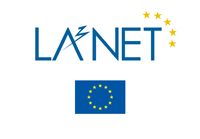Description
In this talk, the research activities on superintense laser-driven ion acceleration under development at Politecnico di Milano (Polimi) are presented.
The discovery in 2000 of brilliant, multi-MeV, collimated ion sources emerging from targets irradiated by intense laser pulses stimulated great interest worldwide, boosted by the ultra-compact spatial scale of the accelerator and the properties of the laser-driven ion beams. The laser-target system provides unique appealing features to fundamental physics, since the acceleration of macroscopic quantities of matter towards GeV/nucleon energies on a microscale and relativistic, collective many-body effects are intrinsically merged, continuously raising new challenging issues which can be studied in a small laboratory scale. Laser driven ion-beams can also have the potential to be used, in the future, in many scientific, technological and medical areas [1].
At Polimi, laser-ion acceleration is investigated both at the theoretical and at the experimental level. The main ion acceleration mechanisms are theoretically investigated, using both simplified analytical models and advanced multi-dimensional particle-in-cell simulations, to achieve deeper, more satisfactory understanding and to propose improvements and optimizations of the basic schemes. A major part of the research is focused on the design, production and testing of micro- and nano-engineered targets whose characteristics are tailored to optimize the production of energetic ions.
As a specific example, the use of multi-layered targets, obtained by deposition of a low density (foam) material on a thin metal foil, will be discussed. The foam material (originally designed, produced and fully characterized at NanoLab, Polimi [2]) can have an average density more than two orders of magnitude lower than the solid material, which fills the gap between the density of solid and gaseous targets. The low-density layer can allow to enhance ion acceleration, as already investigated by numerical simulations [3]. Preliminary, promising laser-ion acceleration experiments using these targets have been conducted [4].
More generally, a brief review of the experimental, theoretical and numerical results activities will be presented, together with an outline of the future programs, with special emphasis on the challenges to be faced to properly understand the behavior of advanced target configurations.
[1] A. Macchi, M. Borghesi, M. Passoni, “Ion acceleration by superintense laser pulses”, Reviews of Modern Physics, 85, 751-793 (2013)
[2] A. Zani, D. Dellasega, V. Russo, M. Passoni, "Ultra-low density carbon foams produced by pulsed laser deposition", Carbon 56, 358 (2013)
[3] A. Sgattoni, P. Londrillo, A. Macchi, M. Passoni, "Laser ion acceleration using a solid target coupled with a low density layer", Phys. Rev. E 85, 036405 (2012)
[4] M. Passoni et al, “Energetic ions at moderate laser intensities using foam based multi-layered targets”, Plasma Phys. Contr. Fusion, in press
Author
Dr
Matteo Passoni
(Dipartimento di Energia, Politecnico di Milano, Italy)
